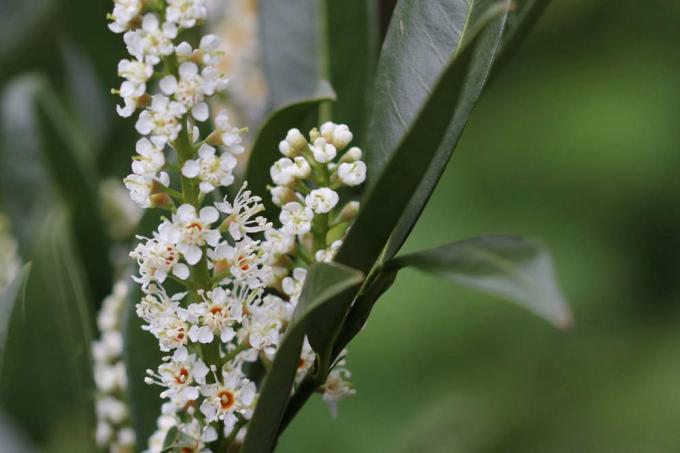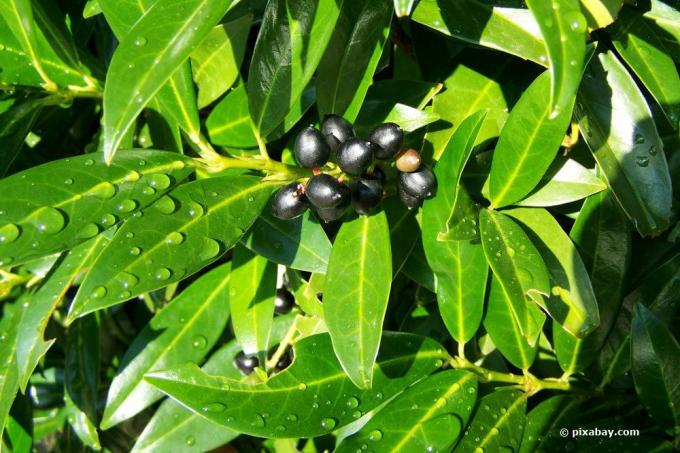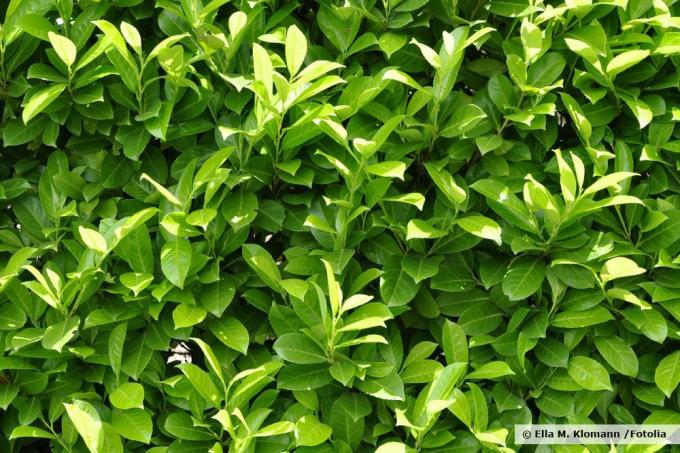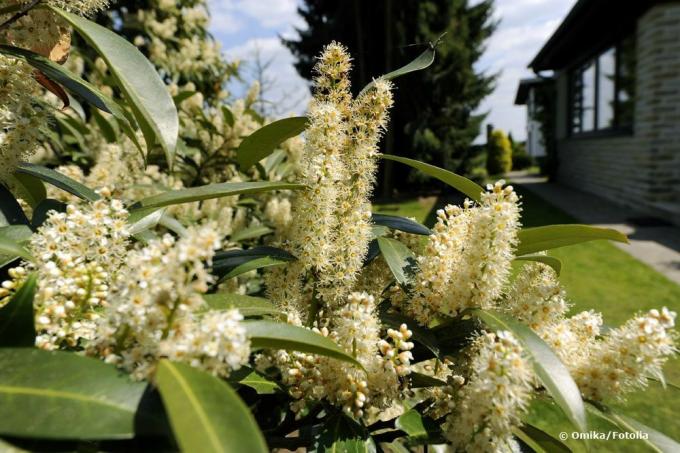
table of contents
- Cherry laurel varieties for a hedge
- Varieties from A - K
- Varieties from L - O
- Varieties with P
- Varieties from R - Z
- Nice varieties for a single place
- Varieties from A - H
- Varieties from K - T
A cherry laurel grows quickly, stays green all the time and survives local winters unscathed. He even lets the secateurs persuade him into a hedge existence. The range of varieties is enormous, but isn't there one specimen like the other? No, not at all. Therefore, do not just compare their prices, but also their properties and needs. You will be amazed at how far they are partially apart. Below is a brief overview of the most common types.
Cherry laurel varieties for a hedge
Prunus laurocerasus, as the botanical name for the evergreen cherry laurel is, is a popular plant for hedges of all kinds. Of the numerous cherry laurel trees offered in this country, however, some varieties are better suited for a life as a hedge than others that want to shine on their own. The special characteristics of a hedge-suitable Prunus laurocerasus are:
- compact growing
- dense foliage
- cut compatible
- Height suitable for hedge
- often growing rapidly
Varieties from A - K
Angustifolia à Italia
This variety belongs to the Portuguese cherry laurel and, with a height of 4 m, is ideally suited as a hedge plant. It grows upright and branches well, its leaves are elongated and shiny green. The winter hardiness is excellent, only the tolerance of the winter sun could be better.
Genolia
Dark green, narrow and leathery, shiny leaves are the hallmark of this type of column. It grows very upright and only slightly in width. The weak growth makes it easier to care for, as the scissors rarely have to be used. Once it has reached the desired height, it leads an existence as "the ideal hedge plant".
Greenpeace
The leaves are bright green in color and have unusual serrations on the edges. In addition, this shrub is hardy, easy to care for and grows into a beautiful exposed wall at an average pace.
Greentorch
A very slow growing variety that is only suitable for a long-term hedge wall. It reaches a height of up to 2.5 m and a width of about 1.5 m. With these ideal dimensions, the scissors don't have to take away much. If so, the bush takes it calmly. Its leaves are oval and glossy.
Herbergii
It is probably the most popular variety that often adorns gardens. It can convince in the middle of a row of hedges as well as a solitary plant. The robust shrub is characterized by its good location tolerance and also withstands strong storms well. The growth is dense and somewhat cone-like. White flowers appear in May and red fruits in autumn.
Varieties from L - O
Leander
All gardeners who count hedge trimmers among their favorite activities can look forward to this variety. The hardy Prunus laurocerasus grows quickly and also likes to be bushy. But he also likes to shorten the shoots and thus trim them into a beautiful hedge block.
Linus
Linus only grows 1.2 m in width, while at the top it easily exceeds 3 m. If there is enough space available, for example in a free-standing hedge wall, further cutting measures are not necessary. The shrub also grows quickly and with dense branches.
Mano
“Square, practical, good” could be the motto of this variety. Both in height and in width it brings it to about 1.5 m. With a little skill, this block can be used to shape interesting things. This cut-compatible plant does not take offense at the use of scissors.
Mari
Mari is a plant that transforms itself into a hedge shape. Both the height of about 2 m and the width are right. The time-poor gardener will be pleased to note this. The secateurs can rust in the garden shed.
Otto Luyken
Cherry laurel 'Otto Luyken' only grows around 20 cm per year, which makes it one of the slow-growing varieties. The height also remains at a modest 1.5 m, but is definitely sufficient for a low hedge. Its numerous narrow, small leaves form a dense and very bushy foliage.
Varieties with P
Piri
This dwarf cherry laurel reaches a minimum height of 1 m and is therefore not suitable as a privacy screen. But if you want a low hedge, this variety is a good choice in this country. It is winter hardy, robust and makes hardly any demands on the location. Due to the compact growth, this cherry laurel can be easily shaped with scissors. As a substitute for the sensitive boxwood, it is always worth considering.
Portuguese cherry laurel
The Portuguese laurel cherry, botanically called Prunus lusitanica, is similar in appearance to the real laurel. This variety is slender but extremely compact and dense. The leaves are small and elongated. The stately height of 6 m is ideal for high hedges and the hardiness of winter gives you a long life in this country too.
Prudonti
A living hedge takes some time to reach its final height. But you don't always want to or can't give her this time. With the fast-growing 'Prudonti', a privacy screen can be set up quickly and then only has to be kept in shape. The green, glossy, leafy variety is also suitable for smaller gardens.
Varieties from R - Z
Renault Ace
This cherry laurel grows quickly and yet forms an opaque hedge. Its shoots reach 3.5 m and the width is also considerable at 2.5 m. This variety has another plus point: It also thrives in the shade and under large trees.
Reynvaanii
This cherry laurel is one of the few varieties that thrive well in a poor location. Even shady places don't stop it from growing its glossy green leaves. It grows to 3 m high and 2 m wide.
Winter star
In the truest sense of the word, this cherry laurel variety is the star of winter, because this robust shrub can easily cope with the freezing cold. The dark green foliage, which has a lighter tone on the underside, is distributed over branches up to 2 m high, which in turn dare to expand 1.8 m in width. Several "winter stars" combine to create a hedge that can withstand strangers' gaze.
Zabeliana
This variety is very wide, 5 m is not uncommon. A couple of specimens in a row are enough to make a broad hedge out of them. The cut tolerance is good and so is the winter hardiness.
Nice varieties for a single place
The appearance of some Prunus laurocerasus is so impressive that they can also be used as solitary plants in the garden. Sometimes it is the shape of the leaves or their color that arouse their admiration. Occasionally also the beautiful and dense growth habit. So that the cherry laurel comes into its own from all sides, a single place with a lot of space is ideal for it. But it is not a must, because many of the varieties described below also like to fit into a hedge wall.
Varieties from A - H
Ani
Ani skilfully plays with the colors when designing the leaves. These are bright red at the beginning and change to green over time. Since this variety does not measure more than 1.5 m even when fully grown, it is also allowed to live in a bucket.
Caucasica
This cherry laurel bush grows very quickly and still remains opaque. Very hard winters can affect it, but it sprouts reliably again in spring. Caucasica is resistant to many diseases and tolerates both sunny and shady locations.
Diana
The special thing about this variety are the copper-colored shoot tips, which form a nice contrast to the old, green leaves. The large, hardy shrub grows slightly funnel-shaped.
Etna
The particularly dense, compact and upright growth makes this variety a suitable specimen plant in the tub. It grows very slowly, but can be pruned well if necessary. The reddish shoot in combination with dark green glossy leaves make this shrub an eye-catcher.
Gajo
Gajo is one of the small-stature varieties, but it is still worth buying. Because of its maximum height of 1 m, this cherry laurel plant is ideal as a border or as a container inhabitant on the terrace.
Hibani
This cultivar is adorned with gracefully elongated leaves and slightly copper-colored new shoots. It is resilient and stays perfectly healthy even in icy winters. Although it can grow up to 3 m, this variety is also suitable for the tub as a specimen plant. It is easy to cut and cuts a good figure when it is trimmed.
Varieties from K - T
Cleopatra
A beautiful cherry laurel that can also decorate the terrace in a pot. It grows as a broad bush and sprouts copper-red tips. Fragrant white flowers appear in May. Despite its beauty, this plant is robust and hardy, can even tolerate drought and shady places.
Marbed White
This laurel cherry grows slowly and forms a multitude of branches. The result is a dense leaf dress, which also impresses with its white marbled leaves. The bush grows up to 2.5 m.
Mischeana
Mischeana is a medium-sized variety with good winter hardiness. She is satisfied with the location assigned to her, even if it does not optimally meet her wishes. The foliage is dark green and the flower can even be seen a second time in September.
Novita
This cherry laurel with its fragrant white spring blossoms is a noble appearance in the garden. A loamy and well-drained garden soil is its preferred location. Undisturbed it grows dense and up to 3 m, but leaves the scissors voluntarily on its branches. It tolerates hard winters and shady places.
Rotundifolia
Belongs to the large-leaved cultivars, has oval and glossy green leaves. In late spring the shrub blooms with creamy white flowers, from which red berries develop in autumn. Dense and rapid growth are typical for this Prunus laurocerasus, as is resistance to strong winds.
Schipkaensis macrophylla
Very large, dark green leaves adorn this variety. It grows very quickly to 3 by 3 m. It is given good resistance to diseases as well as good winter hardiness.
Tico
Tico tolerates pruning, is hardy and reaches a height of around 2.5 m when fully grown. This characterizes many varieties so far, so the focus here is on the flowers. Because these are an extraordinary appearance due to their bronze-colored tone.









